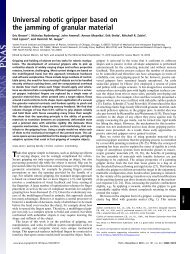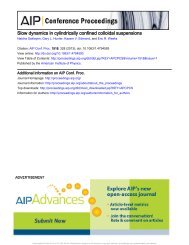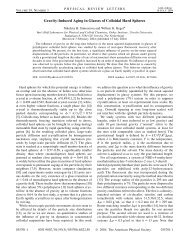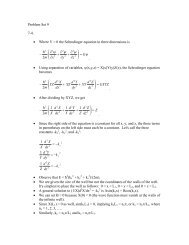Essay contest reveals misconceptions of high school ... - Genetics
Essay contest reveals misconceptions of high school ... - Genetics
Essay contest reveals misconceptions of high school ... - Genetics
Create successful ePaper yourself
Turn your PDF publications into a flip-book with our unique Google optimized e-Paper software.
Copyright Ó 2008 by the <strong>Genetics</strong> Society <strong>of</strong> AmericaDOI: 10.1534/genetics.107.084194<strong>Genetics</strong> EducationInnovations in Teaching and Learning <strong>Genetics</strong>Edited by Patricia J. Pukkila<strong>Essay</strong> Contest Reveals Misconceptions <strong>of</strong> High SchoolStudents in <strong>Genetics</strong> ContentKenna R. Mills Shaw, 1 Katie Van Horne, Hubert Zhang and Joann BoughmanAmerican Society <strong>of</strong> Human <strong>Genetics</strong>, Bethesda, Maryland 20814Manuscript received November 5, 2007Accepted for publication December 21, 2007ABSTRACTNational educational organizations have called upon scientists to become involved in K–12 educationreform. From sporadic interaction with students to more sustained partnerships with teachers, theengagement <strong>of</strong> scientists takes many forms. In this case, scientists from the American Society <strong>of</strong> Human<strong>Genetics</strong> (ASHG), the <strong>Genetics</strong> Society <strong>of</strong> America (GSA), and the National Society <strong>of</strong> Genetic Counselors(NSGC) have partnered to organize an essay <strong>contest</strong> for <strong>high</strong> <strong>school</strong> students as part <strong>of</strong> the activitiessurrounding National DNA Day. We describe a systematic analysis <strong>of</strong> 500 <strong>of</strong> 2443 total essays submitted inresponse to this <strong>contest</strong> over 2 years. Our analysis <strong>reveals</strong> the nature <strong>of</strong> student <strong>misconceptions</strong> ingenetics, the possible sources <strong>of</strong> these <strong>misconceptions</strong>, and potential ways to galvanize genetics education.THE rapid advances in genetic research, the popularity<strong>of</strong>the topic inthenews and in current populartelevision shows (e.g., CSI: Crime Scene Investigation),and the direct role that genetics plays in human healthand reproduction make it a scientific discipline thateveryone needs to understand. Yet, several studies revealthat students fail to critically understand the geneticsknowledge taught in the classroom, and this lack <strong>of</strong>understanding translates to an inability to apply basicknowledge to their everyday lives (Lewis and Wood-Robinson 2000; Lewis and Kattmann 2004).State science standards reflect the important role thatgenetic advances are playing in our lives. More than 80%<strong>of</strong> middle and <strong>high</strong> <strong>school</strong> science standards adoptedsince 2003 include terminology on the Human GenomeProject, bioethics, cloning, stem cells, and/or other biotechnologyterminology that did not exist in previousversions <strong>of</strong> the standards. However, even the adoption <strong>of</strong>national science standards, which include the coverage<strong>of</strong> genetics concepts, does not guarantee understanding<strong>of</strong> the concepts. The compulsory science educationstandards in England and Wales, for example, failed toyield deep conceptual understanding in genetics for1Corresponding author: American Society <strong>of</strong> Human <strong>Genetics</strong>, 9650Rockville Pike, Bethesda, MD 20814. E-mail: kshaw@ashg.orgtheir students (Lewis and Wood-Robinson 2000). Theimportant role genetics plays in society, human health,and our responses to the environment makes thesedeficiencies in genetics content knowledge revealed bystate, national, and international standardized tests evenmore troubling. Therefore, a strategic effort to improvesecondary genetics education is especially needed.MISCONCEPTIONS AND CRITICAL THINKINGOne strategy that can have an impact on student understanding<strong>of</strong> a specific discipline is to encourage deep,critical thinking about that discipline. In an age where atleast superficial information is at our fingertips on alimitless number <strong>of</strong> topics including genetics, we mustfind methods <strong>of</strong> ensuring an enduring understanding<strong>of</strong> this information. Because students <strong>of</strong>ten learn onlypassively through lectures, reading assignments, or cursorysearching <strong>of</strong> the Internet, developing critical thinkingskills is necessary to ensure a level <strong>of</strong> literacy and theeventual ability to apply the knowledge (Connallyand Vilardi 1989; Rivard 1994; Keys 1999). Providingstudents with an opportunity to explore challengingareas in genetics through writing is one manner <strong>of</strong>achieving this goal.Research on student learning suggests that student<strong>misconceptions</strong> serve as barriers to student achieve-<strong>Genetics</strong> 178: 1157–1168 (March 2008)
1158 K. R. Mills Shaw et al.TABLE 1NAEP test results in 2000 for science reveal a deficit in student understanding <strong>of</strong>core genetics concepts (O’SULLIVAN et al. 2003)ThemeGradeStudents withcomplete/essentialanswers (%)Students withpartial answer (%)Students withunsatisfactoryanswer (%)Classification 8 23 16 58Theory <strong>of</strong> evolution 8 53 NA 45Reproduction 12 61 NA 39Evolutionary relationships 12 25 NA 70Darwin’s theory <strong>of</strong> evolution 12 51 NA 47Genes a 12 21 45 30Mutation a 12 2 33 58Interpreting genetic material a 12 1 1 83Genetic disease a 12 5 31 56Recombinant DNA usage a 12 8 27 58Percentages may not total to 100 due to rounding and student omission (i.e., no answer was given).aThese questions are in the molecular and human genetics category.ment. These <strong>misconceptions</strong> are <strong>of</strong>ten based on personalexperiences and are difficult to bypass en routeto meaningful understanding in any content area(Gelman and Gallistel 1986; Wellman 1990). Evenafter instruction designed to address scientific content inan area where <strong>misconceptions</strong> are held, many studentsdo not reconstruct their thinking. Only those studentsable to deconstruct their knowledge and reconstruct itusing critical thinking and logical reasoning appear tohave fewer <strong>misconceptions</strong> even after <strong>high</strong>-quality instruction(Lawson and Thompson 1988). Similarly,conceptual change generally occurs only if a learning experiencecan demonstrate both that a student’s explanationis insufficient and that an alternative explanationis more applicable (Posner et al. 1982).The National Assessment <strong>of</strong> Education Progress(NAEP) assesses pr<strong>of</strong>iciency <strong>of</strong> U.S. students in a variety<strong>of</strong> content areas, including science, using a randomsampling <strong>of</strong> students from the 4th, 8th, and 12th grades.The last NAEP tests in science were administered in1996, 2000, and 2005. Unfortunately, the data from the2005 test is still not completely accessible to the public.However, an analysis <strong>of</strong> the 2000 NAEP test results<strong>reveals</strong> dramatic deficiencies in genetics content knowledgeat both 8th and 12th grades. Mastery <strong>of</strong> 12 conceptsfrom earth, physical, and life sciences is requiredfor students to demonstrate pr<strong>of</strong>icient or advancedknowledge in the sciences; one-quarter <strong>of</strong> these conceptsare in the field <strong>of</strong> genetics (O’Sullivan et al.2003). The NAEP test results reveal specific deficits instudent understanding <strong>of</strong> classification, evolution, mutation,and DNA technology as shown in Table 1.Publicly available data on the 2000 NAEP scienceassessment (at http://nces.ed.gov/) provides samplequestions and answers from students, as well as thecriteria for scoring answers as ‘‘complete or essential,partial, or unsatisfactory.’’ We specifically examined thesubset <strong>of</strong> data regarding the broad category <strong>of</strong> molecularand human genetics (footnote a in Table 1).All questions referring to genes, mutation, cell differentiation,genetic disease, and recombinant DNAusage for 12th grade students had a difficulty <strong>of</strong> ‘‘hard’’and required a written response. This type <strong>of</strong> questionenables investigators to explore student thinking inmore depth. The example for the year 2000 provided anadapted text that was taken from an article in the March1990 issue <strong>of</strong> Discover magazine. This article was basedon the work <strong>of</strong> Richard Mulligan and other geneticiststhat are currently examining the use <strong>of</strong> viruses as vehiclesfor introducing genes into human cells as a form <strong>of</strong>therapy for genetic diseases in humans. A majority <strong>of</strong>students were not able to describe a gene, its structure,or its function. It was very rare for students to have athorough understanding <strong>of</strong> the types <strong>of</strong> mutations thatoccur, the causes <strong>of</strong> those mutations, and the physiologicaleffect <strong>of</strong> gene alterations. Moreover, few wereable to transfer the knowledge from the article to theinformation they had learned in class about inheriteddiseases.Therefore, to encourage a transformation from passiveknowledge in genetics gained via classroom lectures,the National DNA Day <strong>Essay</strong> Contest (http://www.genednet.org/pages/k12_dnaday08.shtml) was establishedby K. R. Mills Shaw, Director <strong>of</strong> Education atthe American Society <strong>of</strong> Human <strong>Genetics</strong> (ASHG), toprovide a distinct opportunity for students to thinkcritically and articulate scientific arguments related togenetics. Teachers from across the country were invitedto participate through list serves, blast e-mails, and theASHG education website, http://www.genednet.org. Eachyear two questions have been provided: one to allowstudents to explore the methods and research that geneticsentails and the second to explore the ethical, legal,and social issues influenced by genetics (see Table 2).
Year<strong>Genetics</strong> Education 1159TABLE 2<strong>Essay</strong> <strong>contest</strong> questions in 2006 and 2007Question2006 Why is it important for everyone to know about genetics?2006 and 2007 If you could be a human genetics researcher, what would you study and why?2007 In what ways will knowledge <strong>of</strong> genetics and genomics make changes to healthand health care in the United States possible?Table 3 summarizes the number <strong>of</strong> essays submittedduring each year <strong>of</strong> the <strong>contest</strong>. The students who wrotethe top three essays for each question were declaredfirst, second, and third place winners through thejudging process described in methods. These studentswere awarded $350, $250, and $150, respectively. Themonetary awards were made possible by the sponsorship<strong>of</strong> Applied Biosystems (Foster City, CA). While manyessays demonstrated a clear understanding <strong>of</strong> geneticsand its implications, a significant number <strong>of</strong> contributedessays revealed firmly held misinformation and<strong>misconceptions</strong> by U.S. students in grades 9–12. Thisarticle examines those <strong>misconceptions</strong>, provides possibleexplanations for their origins, and suggests ways thatscientists, pr<strong>of</strong>essors, and teachers can collaborate toimprove genetics education at the K–12 level.METHODSJudging <strong>of</strong> essays: All aspects <strong>of</strong> the National DNADay <strong>Essay</strong> Contest were managed online from initialadvertisement to final judging. Information technologyspecialists from ASHG and the <strong>Genetics</strong> Society <strong>of</strong>America (GSA) were able to adapt existing societyresources to facilitate essay acceptance, cataloging, andscoring. Judges were recruited from the active membership<strong>of</strong> ASHG, GSA, and the National Society <strong>of</strong> <strong>Genetics</strong>Counselors (NSGC). Three groups <strong>of</strong> judges were utilized.Each year students were given a choice betweentwo essay questions. The questions from 2006 and 2007are <strong>high</strong>lighted in Table 2. The first group <strong>of</strong> judges readlarge groups <strong>of</strong> essays on either <strong>of</strong> the two essay topics,scanning these essays to ensure they fulfilled all criteriaand addressed all aspects <strong>of</strong> the judging criteria. Thecriteria were slightly different for each <strong>of</strong> the twoquestions and were all published online for all studentsand teachers. The scoring criteria for the 2007 questionsare documented in Table 4. <strong>Essay</strong>s not fulfilling thesecriteria after being reviewed by at least two judges wereremoved from more detailed consideration. The secondgroup <strong>of</strong> judges scored 10–15 essays in depth, providinga score (from 1 to 10) in each <strong>of</strong> the five categories.Each essay was scored by at least three independentjudges. Scores were tabulated and the 10 essays with the<strong>high</strong>est scores for each topic were named as finalists.The last set <strong>of</strong> judges reviewed and scored each <strong>of</strong> thefinalist essays with the <strong>high</strong>est-scoring essays beingchosen as winners. One hundred ten members <strong>of</strong> theASHG, GSA, or NSGC membership served as judgeseach year. The entire adjudication process is reviewed inFigure 1. This system allowed us to perform all judginganonymously and ensure that each essay was read andscored by multiple independent reviewers while simultaneouslyinvestigating each essay for scientific accuracy.Identification <strong>of</strong> <strong>misconceptions</strong>: All judges, alongwith scientists on ASHG staff, were asked to examineeach essay for <strong>misconceptions</strong> or incorrect statementsand forward this information along with their scores. All<strong>misconceptions</strong> were collected over 2 years from individualjudges but were placed into categories by twoindividual coders (K. R. Mills Shaw and K. Van Horne)on the basis <strong>of</strong> the genetic topic that the misconceptionaddressed (Table 5). These topics were generated denovo after reviewing all the <strong>misconceptions</strong> submittedfrom judges and after K. R. Mills Shaw and K. Van Horneadditionally independently evaluated 125 randomlyselected essays from each year (2006 and 2007). All<strong>misconceptions</strong> were then cataloged under these specifictopic areas to better characterize the areas where<strong>misconceptions</strong> are most common (seen in Table 6).Five hundred essays, or 20%, were randomly selected forthis level <strong>of</strong> systematic review. Specifically, every fourthessay was analyzed in detail. If, however, essays weredeemed completely unsatisfactory for review (e.g., tooshort, too poorly defined, too poorly written), the essaywas not included in the systematically reviewed sample<strong>of</strong> 500. A misconception/misunderstanding was identifiedas any clearly written statement that did notaccurately reflect the nature <strong>of</strong> genetic science, technology,or research as defined by K. R. Mills Shaw andJ. A. Boughman, both Ph.D. scientists with a backgroundin genetics. <strong>Essay</strong>s where language or communicationbarriers were obvious (due to vocabulary, grammatical,TABLE 3<strong>Essay</strong> <strong>contest</strong> participation in 2006 and 20072006 2007Total number <strong>of</strong> essays received 1519 927Number <strong>of</strong> states represented 27 42Number <strong>of</strong> teachers represented 165 387
1160 K. R. Mills Shaw et al.TABLE 4<strong>Essay</strong> <strong>contest</strong> scoring guidelines for 2007Question Topic to be included Points possibleIf you could be a humangenetics researcher,what would you study and why?In what ways will knowledge<strong>of</strong> genetics and genomics makechanges to health and healthcare in the United States possible?Development/statement <strong>of</strong> hypothesis 10Discussion <strong>of</strong> current knowledge in field 10Discussion <strong>of</strong> importance <strong>of</strong> research topic 10Discussion <strong>of</strong> experimental design 10Presentation (spelling and grammar) 10Discussion <strong>of</strong> the knowledge we are10gaining in genomicsDiscussion <strong>of</strong> the current state <strong>of</strong> health care 10Discussion <strong>of</strong> potential changes at a personal level 10Discussion <strong>of</strong> potential changes at a broader level 10Presentation (spelling and grammar) 10and spelling errors) were not included as part <strong>of</strong> thisreview. Once <strong>misconceptions</strong> were identified, codersboth independently and in communication with eachother cataloged <strong>misconceptions</strong> according to topic toensure consistency in grouping. The quantitation <strong>of</strong> theexamples revealed in this article reflects observationsfrom analysis <strong>of</strong> the critical writing from 500 <strong>high</strong> <strong>school</strong>essays (9th–12th grade submissions).RESULTS<strong>Essay</strong>s collected represent data from multiple states,grades, and classroom teachers: All essays were submittedonline. In the online submission form wecollected demographic data on all students and theirteachers, including their grade, city, state, and <strong>school</strong>. Inboth years <strong>of</strong> the <strong>contest</strong> we included a rule that statedonly three essays per teacher for each question, for atotal <strong>of</strong> six essays per teacher, would be accepted.However, this rule was <strong>of</strong>ten overlooked, and teacherswould submit essays from their entire classrooms. Thus,while we collected more essays in 2006, this total number<strong>of</strong> essays reflects a representation <strong>of</strong> fewer classrooms. In2007 we rectified this problem by adding an algorithmthat blocked any more than three essays from the sameteacher. The data presented in Table 3 show that theessay <strong>contest</strong> grew between years 1 and 2 in the overallnumber <strong>of</strong> classrooms reached and that the essays collectedrepresent a wide geographical distribution. In2007, we did not receive essays from Alaska, Hawaii,Vermont, South Dakota, Wyoming, Maine, Washington,DC, Nebraska, or Mississippi despite sending out multiplee-mail solicitations to teacher contacts in those states.Identification <strong>of</strong> <strong>misconceptions</strong> and misinformationfrom student essays: During the process <strong>of</strong> readingand scoring essays, judges were asked to identify anddocument examples <strong>of</strong> <strong>misconceptions</strong> in their essays.Additionally, all essays were cursorily scanned by eitherK. R. Mills Shaw or K. Van Horne. Tables 5 and 6 providean overview <strong>of</strong> the topics where <strong>misconceptions</strong> arecommon as well sample statements taken directly fromstudent essays. While several hundred individual <strong>misconceptions</strong>were identified during the course <strong>of</strong>judging and review, many <strong>of</strong> the individual misconcep-Figure 1.—Schematic <strong>of</strong> process involved inselecting finalist essays.
<strong>Genetics</strong> Education 1161TABLE 5Key ideas/subtopics used to categorize <strong>misconceptions</strong>TopicGenetic technologyDeterministic nature <strong>of</strong> genesPatterns <strong>of</strong> inheritanceNature <strong>of</strong> genes and genetic materialsGenetic basis <strong>of</strong> disease<strong>Genetics</strong> researchReproductive technologyKey ideas/subtopicsRealistic vs. nonrealistic uses‘‘Genohype’’Role <strong>of</strong> gene therapy in curing genetic diseaseGenes determine all traitsOne gene, one traitLack <strong>of</strong> environmental influenceLack <strong>of</strong> multigene involvement in traitsProbabilityTypes <strong>of</strong> inheritanceMisunderstanding modes <strong>of</strong> inheritanceInterpretation <strong>of</strong> data from Punnett squaresUnderstanding the origin <strong>of</strong> chromosomal anomalies(monosomies, trisomies)Role <strong>of</strong> different nucleic acids in geneticsCentral dogmaDescription <strong>of</strong> a geneChromosomes and genesDNA and living organismsMultigene involvement in diseaseEnvironmental influence in diseaseDifference between genetic and inherited diseaseDifference between viral, sexually transmitted,and genetic diseasesProcess <strong>of</strong> researchTime frame <strong>of</strong> researchTopics <strong>of</strong> researchEugenicsCloningPreimplantation genetic diagnosistions could be categorized under broad topics in genetics(summarized in Table 5). To quantify the frequency<strong>of</strong> these common <strong>misconceptions</strong> we reanalyzed500 (20%) <strong>of</strong> the essays, which included 250 essayschosen at random from each year’s submissions. Individual<strong>misconceptions</strong> were identified and cataloged.After cataloging each misconception in the 500 essaysand defining the categories <strong>of</strong> genetics in which theyfell, ‘‘common’’ categories were defined by those beingpresent in at least 5% <strong>of</strong> the essays examined. Of the 500systematically reviewed essays, 278 (55.6%) revealed atleast one obvious misconception. Another 101 essays(20.2%) were recognized for having two or more <strong>misconceptions</strong>.Misconceptions that were linked to essayswith obvious language or writing barriers were excludedfrom quantitative analysis to avoid overrepresentationin our quantitative analysis. The prevalence <strong>of</strong> <strong>misconceptions</strong>per topic area is summarized in Figure 2.Standards and common areas <strong>of</strong> <strong>misconceptions</strong>:Misconceptions were identified and categorized into ageneral topic area. We then examined how standardswere related to these main topic areas, specificallypatterns <strong>of</strong> inheritance and the deterministic nature <strong>of</strong>genes. We analyzed 20 sets <strong>of</strong> state biology standardsat random to determine the nature <strong>of</strong> the standards inpatterns <strong>of</strong> inheritance at the introductory biology orlife science level in <strong>high</strong> <strong>school</strong>. Supplemental Table 1at http://www.genetics.org/supplemental/ <strong>high</strong>lightsfour sets <strong>of</strong> these standards that provide a range <strong>of</strong>coverage <strong>of</strong> patterns <strong>of</strong> inheritance. A majority <strong>of</strong> thesebasic genetics/cell biology standards (15/20) includedan examination <strong>of</strong> Mendel’s laws <strong>of</strong> inheritance, somespecifically describing the requirement to understandprobability, Punnett squares, and the differences betweenautosomal dominant, autosomal recessive, andsex-linked traits. Other states included only more broaddescriptions where a student would, for example,‘‘Explain current scientific ideas and information aboutthe molecular and genetic basis <strong>of</strong> heredity’’ (see supplementalTable 1). These are important data becausethey reflect the <strong>high</strong>ly diverse nature <strong>of</strong> the level <strong>of</strong> detailrequired <strong>of</strong> students in U.S. <strong>high</strong> <strong>school</strong>s. While standardsthat fail to provide comprehensive detail allowtalented teachers to provide creative and challenginglearning opportunities for students, they can <strong>of</strong>tenalso result in learning experiences that fail to
1162 K. R. Mills Shaw et al.TABLE 6Common <strong>misconceptions</strong> revealed in student essaysTheme Quotation from student essay a Correct conceptionGenetic technologies ‘‘When people who cannot have children and want their ownfrom their own blood, meaning having their genes, whatwill stop them from putting some cells into a cow to gettheir child?’’‘‘Currently though there are some abnormalities in theseanimals being ‘cloned’ (cloned being that mammalscannot asexually reproduce but the technology in thescience field today can do it for them....’’‘‘Similarly, in the germline gene therapy new genes would beadded to the cells. With this it is possible that any trait canbe added to an embryo and produce a ‘‘tailor made child’’.With more research more would be found about thehuman genome and the sooner parents would be able toselect certain traits for a child, but this won’t happen for acouple <strong>of</strong> decades.’’This likely stems from the ideas that organs for potentialtransplant are being grown in different species. However,genetics as a field is not considering growing humanembryos using other species as incubators.Cloning in this sense actually refers to somatic cell nucleartransfer and does not refer to a reproductive technique forasexually reproducing organisms.The practice <strong>of</strong> eugenics as an acceptable technology inhuman reproductive technology ended decades ago.Moreover, this does not take into consideration the role <strong>of</strong>environment and other epigenetic factors in thedevelopment <strong>of</strong> specific attributes.Patterns <strong>of</strong> inheritance ‘‘If you were to have three chromosomes instead <strong>of</strong> thenormal two, that child will have Down syndrome.’’‘‘Half <strong>of</strong> your DNA is determined by your mother’s side, andhalf is by your father. So, say, if you seem to look exactly likeyour mother, and had gotten all phenotypes from her,perhaps some DNA that codes for your body and how yourorgans run was copied from your father’s genetic makeup.’’‘‘ADA is hereditary and must be inherited from both <strong>of</strong> theparents... . There is a 25% chance <strong>of</strong> having a child withADA deficiency if neither parent carries the gene. There is a50% chance <strong>of</strong> having a child with this disease if one parentcarries the gene and the other doesn’t. There is a 100%chance <strong>of</strong> having at least one child with ADA Deficiency ifboth parents are ADA positive. Two people with ADADeficiency will almost definitely have at least one, orpossibly more than one child who suffers from this disease.Some children <strong>of</strong> one parent with the disease will at leastbecome a carrier, even if they never show any signs <strong>of</strong>having the disease. They can pass it on or have a child withthe disease that is a dominant trait.’’‘‘One study showed that chemical dependency skips a generation.This would make the gene for chemical dependency recessive.This means that if a psychiatric geneticist would make aPunnett square for two parents whose parents had chemicaldependency, the Punnett square would say that 3 out <strong>of</strong> 4 <strong>of</strong>their children would be chemically dependant.’’Humans have 23 pairs <strong>of</strong> chromosomes. Only an extra copy <strong>of</strong>chromosome 21 causes Down syndrome.Each cell in the body contains two copies <strong>of</strong> eachchromosome, and therefore each gene, one copy from themother and the other from the father. Both alleles maycontribute to all attributes/traits that are geneticallycontrolled. Moreover, most gene products (proteins)interact with other genes and do not act in isolation.Adenosine deaminase deficiency (ADA) is caused by amutation in a gene on chromosome 20 and is autosomalrecessive. This means that to have the disorder, anindividual must inherit a mutation in this gene from boththe mother and the father. The chances <strong>of</strong> a child beingdiagnosed with ADA from parents that do not carry themutation is extremely rare, >25%. If one parent is acarrier, there is only a 50% chance <strong>of</strong> the <strong>of</strong>fspring alsobeing a carrier. A carrier is does not experience anysymptoms <strong>of</strong> an ADA patient. This is just one example <strong>of</strong>many <strong>of</strong> the recessively inherited disorders whoseinheritance was not accurately described by students.Chemical dependency is a complex trait that cannot beexplained by a simple, monohybrid Punnett square cross.(continued )
<strong>Genetics</strong> Education 1163TABLE 6(Continued)Theme Quotation from student essay a Correct conceptionDeterministic nature <strong>of</strong>genetics‘‘Genes determine everything form your sex, and hair color, towhat diseases you many have and how <strong>high</strong> you will grow.’’‘‘If everyone on both sides <strong>of</strong> your family is tall, you are goingto be tall. If half are tall and half are short, you have a 50/50chance <strong>of</strong> being either tall or short. You also have thepossibility <strong>of</strong> being somewhere in the middle.’’Genes are not necessarily deterministic. More frequently,environmental influences coupled with genotypedetermine phenotype.This quotation appears to assume that single genes (perhapstaken from a simple Punnett square idea) determineheight. Indeed, multiple genes, nutrition, andenvironment all play a role.Nature <strong>of</strong> genes andgenetic material‘‘All humans have DNA, as do animals, plants, and mostbacteria and fungi.’’‘‘Much like iodine is frequently added to the salt we consume,natural pesticides, extra vitamins, and longer life spans canbe added to our fruits and vegetables.’’All living organisms, including bacteria and fungi, have DNA.Genetic modification <strong>of</strong> organisms is an extensive, lengthyprocess not analogous to the simple addition <strong>of</strong> a chemical.Genetic basis <strong>of</strong> disease ‘‘In the future knowledge about genetics could help stopdeadly diseases and cancers. However this will only helpwith diseases that are hereditary.’’Most illnesses have a genetic component without beinghereditary. Therefore, a knowledge <strong>of</strong> genetics could have amuch farther reach than this student recognizes. Indeed,the knowledge <strong>of</strong> the genetics <strong>of</strong> different viruses, forexample, has resulted in vaccines for strains <strong>of</strong> influenza(Webby et al. 2004).<strong>Genetics</strong> research ‘‘If I could be a human genetics researcher I would studymolecular genetics and how to alter it. One <strong>of</strong> the biggestproblems to humanity is disease and if by studying DNA andthe molecules that it is composed <strong>of</strong>, certain things couldbe stopped it would be well worth it.’’‘‘An experimental design I would like to try would to havepeople have the ability to hibernate in a frozen state,replicating the ability <strong>of</strong> the wood frog.’’While many geneticists study molecular genetics, they do so byfocusing on a particular process, gene, or other aspect <strong>of</strong>this broader topic. Moreover, there is <strong>of</strong>ten a large gapbetween the basic research ongoing in molecular geneticsand human disease prevention, treatment, and cure.In the 2007 guidelines, students were asked to include theirexperimental design (see Table 4). Only 11% <strong>of</strong> studentsanswering this question included any type <strong>of</strong> discussion ontheir experimental design. Moreover, students rarelyexhibited understanding <strong>of</strong> a rational, reasoned approachto a testable hypothesis.Reproductive technology ‘‘<strong>Genetics</strong> create a perfect being. Change the genes. Makethat child perfect. There’s no better solution to animpending health care crisis. A perfect child means thathealth care can be focused on an aging generation <strong>of</strong> people.What we can have is a sea <strong>of</strong> people who all look brilliant, whoare all smart and who all have perfect eyes, nose and lips. It’s aperfect society, what more could we want?’’The goal <strong>of</strong> genetics, genetic research, and reproductivetechnology is not eugenic in nature. While scientists andclinicians indeed want to identify mutations that result inhuman illness for subsequent development <strong>of</strong> effectivetreatments (and potential cures), their ultimate goal is notto presume to name the traits that would be consideredvaluable in society.aQuotations are copied directly from student text and not edited for correct grammar.
1164 K. R. Mills Shaw et al.Figure 2.—Prevalence <strong>of</strong> <strong>misconceptions</strong>by genetics topic. Atotal <strong>of</strong> 500 essays were chosen atrandom (20% <strong>of</strong> total submitted)and were systematically reviewedfor <strong>misconceptions</strong>. Frequently observedtopics <strong>of</strong> <strong>misconceptions</strong>were identified and essays werecataloged on the basis <strong>of</strong> the type(s)<strong>of</strong> misconception(s) they revealed.effectively teach students even the most basic conceptsin biology.Genetic technologies: The single greatest number <strong>of</strong><strong>misconceptions</strong> identified from student essays could bebroadly defined as falling into the category <strong>of</strong> ‘‘genetictechnologies.’’ When answering the question ‘‘If youwere a genetics researcher, what would you study andwhy?’’ students <strong>of</strong>ten expressed their goal <strong>of</strong> curingmultiple unrelated diseases. The reality is that mostgenetics researchers are <strong>of</strong>ten several steps removedfrom work on specific cures but instead devote theirefforts to improving the molecular understanding <strong>of</strong>disease with the ultimate goal <strong>of</strong> improved treatments.Moreover, scientists generally study only one specificillness or class or related diseases. The work scientistscurrently perform to identify a disease-causing mutationis prominent in student essays with the commonextrapolation to the ‘‘curing’’ <strong>of</strong> disease through genereplacement. Often, student essays also suggested thatgenetic engineering allows us to put a gene from anyspecies into another species to have that trait expressedin exactly the same manner as in the original species.Students do not understand the complexity <strong>of</strong> biotechnologyand genetic engineering. They make broadleaps without demonstrating an understanding for themultiple genetic and epigenetic (or environmental) factorsthat play a role in genetic regulation and manipulation<strong>of</strong> genetic materials in the laboratory setting.Moreover, there is a disconnect between observedcharacteristics and the physiological function <strong>of</strong> genes:We could eliminate all the premature deaths <strong>of</strong> peopledying around the world from thirst if we geneticallymodified people to inherit some <strong>of</strong> the characteristics<strong>of</strong> the camel, allowing them to go for months at a timewithout drinking water.Finally, we note the prevalence <strong>of</strong> essays that includedinformation on the importance <strong>of</strong> stem cell research.While clearly a prevalent topic in the popular literatureand press, students <strong>of</strong>ten discussed stem cell biologywithout ever discussing the genetics <strong>of</strong> stem cells. We didnot include essays that included information on stemcells in our quantitative analysis. However, we note thatscanning our database from 2006 for all references <strong>of</strong>‘‘stem cells’’ revealed that almost one-quarter <strong>of</strong> essaysubmissions included this terminology without activelyexploring the genetic nature <strong>of</strong> these cells despite theclear genetics-oriented nature <strong>of</strong> the essay questions.Deterministic nature <strong>of</strong> genes: Another commonmisconception we observed is that one gene is alwaysresponsible for one trait or one gene with one mutationalways causes one disease. The discovery <strong>of</strong> genes thatconvey and determine a specific phenotype is <strong>of</strong>tendisplayed and hyped in the media. A cursory search <strong>of</strong>online news outlets yielded example headlines thatcould easily be misinterpreted, adding credibility tostudents’ <strong>misconceptions</strong>. Some examples include thefollowing titles: ‘‘Turning Off Suspect Gene Makes MiceSmarter’’ (nytimes.com, May 29, 2007) and ‘‘Researchersnarrow search for longevity gene’’ (cnn.com, August28, 2001). It is important for students to understand thatit is rare that a single gene has complete control over anexhibited phenotype. Instead, multiple factors contributeto phenotype. Multiple genes <strong>of</strong>ten work together,with the environment, to determine ultimate phenotype.Our examination <strong>of</strong> standards revealed that only 3<strong>of</strong> 20 state standards specifically mentioned that studentsshould learn about polygenic inheritance (thatmore than one gene can contribute to a specific phenotype)and only 2 described the role <strong>of</strong> the environmentin controlling phenotype. Thus, it is not surprisingthat we would see a common misconception that singlegenes are the cause <strong>of</strong> most traits and inherited diseases.Compared to the general nature <strong>of</strong> genetic inheritance,far fewer students would have necessarily been exposedto the concepts <strong>of</strong> non-Mendelian and polygenicinheritance.Patterns <strong>of</strong> inheritance: Patterns <strong>of</strong> inheritance wasanother topic that revealed numerous <strong>misconceptions</strong>and misunderstandings <strong>of</strong> students. Not only were students<strong>of</strong>ten unable to correctly describe the nature <strong>of</strong>simple dominant and recessive patterns <strong>of</strong> inheritance,but also they were not able to go into any level <strong>of</strong> depthregarding genes or alleles, the physiological function <strong>of</strong>genes (proteins), or non-Mendelian patterns <strong>of</strong> inheritance.Some students even described genetic technologiesas being able to ‘‘prevent the inheritance’’ <strong>of</strong> diseasegenes. Students focused primarily on simple Mendelianinheritance that was able to be analyzed via Punnettsquare analysis. All students described only monogenictraits that followed simple autosomal dominant, autoso-
<strong>Genetics</strong> Education 1165mal recessive, or X-linked inheritance. Students were<strong>of</strong>ten unable to adequately describe sources <strong>of</strong> abnormalchromosome numbers. <strong>Essay</strong>s did not mentionerrors during meiotic cell division and generation <strong>of</strong>gametes as the source <strong>of</strong> monosomies or trisomies. Ourreview <strong>of</strong> state science standards for <strong>high</strong> <strong>school</strong> studentsin biology suggests, not surprisingly, that the majority <strong>of</strong>states provide specific, detailed standards that mandateteaching students, even at the earliest levels <strong>of</strong> their lifescience education in <strong>high</strong> <strong>school</strong>, the basic biology <strong>of</strong>inheritance patterns. Although 15 <strong>of</strong> the 20 biologystandards included basic patterns <strong>of</strong> inheritance knowledge,when we reviewed the essays that were catalogedas having an error or a misconception falling under‘‘patterns <strong>of</strong> inheritance,’’ 80% <strong>of</strong> those essays inaccuratelydescribed a basic tenet <strong>of</strong> Mendelian inheritance,despite their expected coverage <strong>of</strong> this material at theircurrent grade level or in previous biology courses.Nature <strong>of</strong> genes and genetic material: All 20 statestandards examined require coverage <strong>of</strong> the nature <strong>of</strong>DNA as the hereditary material in living things. Nevertheless,students suggested that lower organisms, includingbacteria and fungi, <strong>of</strong>ten do not carry DNA. Wealso noted student confusion regarding the hierarchalorganization <strong>of</strong> genetic material. Notably, students werefrequently unable to accurately define DNA, genes, andchromosomes. Often, these terms were instead usedinterchangeably. In 2007, ,1% <strong>of</strong> essays included anyinformation on additional genetic material in thegenome. Students did not mention gene expressioncontrol elements, repetitive sequences (unless discussingHuntington’s disease), or other nongene elementsin the genome. Finally, students <strong>of</strong>ten described specificprotein-encoding segments, or genes, as discrete elementsthat could easily be removed from one contextand added in a separate context. While this view likelyextends from students learning basic biotechnology andbacterial transformation techniques (for example, addingthe green fluorescent protein from jellyfish tobacterial strains), likening this process to the adding <strong>of</strong>a chemical to a solution is an oversimplification, at best.Genetic basis <strong>of</strong> disease: One <strong>of</strong> the principle errorsobserved in this category was the confusion <strong>of</strong> ‘‘hereditary’’and ‘‘genetic’’ when describing diseases. In a smallsubset <strong>of</strong> cases, 10% <strong>of</strong> the total essays categorized ashaving a misconception in this topic, students completelymisrepresented the genetic nature <strong>of</strong> a specificillness (e.g., calling HIV-1 an inherited disorder). Whilemost illnesses have a genetic component, this does notmake them hereditary. Moreover, while even infectiousdiseases can be considered to have a genetic componentwhether it be <strong>of</strong> the genetics <strong>of</strong> the virus itself or howindividual genetics could result in different manifestations<strong>of</strong> the same illness, students must learn to clarifythese differences. Cancer is a genetic disease. Only rarecancers, however, are hereditary. However, students<strong>of</strong>ten described breast and ovarian cancer as hereditarydue to the mutations in BRCA1 or BRCA2. Whilemutations in these genes <strong>of</strong>ten do result in a cancerpredisposition that appears to be inherited in a dominant-likefashion, the majority <strong>of</strong> breast cancer cases arenot due to mutations in these genes.<strong>Genetics</strong> research: A large number <strong>of</strong> student essaysfocused on the promise <strong>of</strong> genetic engineering inhuman health and reproduction (see also the Reproductivetechnologies section). While superficially this reflectsthat students recognize the positive influence that thestudy <strong>of</strong> genetics can have in their lives, numerous <strong>misconceptions</strong>suggest that students still fail to truly understandthe nature and limitations <strong>of</strong> genetic research.An examination <strong>of</strong> state science standards, briefly describedabove, <strong>reveals</strong> that while state and national process(not necessarily content) standards require coverage<strong>of</strong> the nature <strong>of</strong> scientific research, inquiry, and discovery,this does not necessarily equate to students learningabout how scientists actively perform research. Instead,these process standards reflect the fact that teachers areexpected to provide students with opportunities forinquiry and investigation in the context <strong>of</strong> their ownclassroom laboratory experiments and activities. Inshort, state science standards do not require studentsto learn about the nature <strong>of</strong> scientific research.Reproductive technologies: Misconceptions fallingunder the category <strong>of</strong> ‘‘reproductive technologies’’could have been accurately cataloged under genetictechnologies. However, this class <strong>of</strong> <strong>misconceptions</strong> wasfrequent enough to require special treatment. In thesecases students continued to explore their ideas <strong>of</strong>genetic engineering and cloning to describe the future<strong>of</strong> reproductive control where prospective parents would‘‘improve’’ and ‘‘design’’ their <strong>of</strong>fspring, with the ultimategoal <strong>of</strong> having the ‘‘perfect’’ child. Eugenics, eitherin specific use <strong>of</strong> terminology or in concept, appeared in15% <strong>of</strong> essays collected in 2007. This percentage is notreflective <strong>of</strong> the goals or ongoing work <strong>of</strong> genetics research.Unfortunately, its prevalence in student essays islikely due to both its historical role in research as well asthe ‘‘genohype.’’ Interestingly, the idea behind eugenicsis not overtly described in the standards <strong>of</strong> any statescience standards that we explored. The frequency <strong>of</strong> studentsdescribing using genetics to improve genotypesand design human beings, however, suggests that this iseither the hook that teachers are using or the messagethat students are hearing from the media. More researchwould be required to determine which <strong>of</strong> these optionsis most prevalent.DISCUSSIONRole <strong>of</strong> standards: State science standards are not theonly source <strong>of</strong> direction for what is taught in public<strong>school</strong>s; textbooks, laboratories, statewide assessments,and teacher quality also play significant roles. These
1166 K. R. Mills Shaw et al.benchmarks serve as the cornerstone <strong>of</strong> ‘‘standardsbasedreform,’’ which has become prominent since theadoption <strong>of</strong> the ‘‘No Child Left Behind’’ legislation’srequirement for stricter accountability <strong>of</strong> studentachievement. After examining multiple state standards,it became clear that there is extreme variation betweenthe levels <strong>of</strong> breadth and depth that individual statesrequire <strong>of</strong> students at the same educational level (supplementalTable 1). Teachers rightly demand a balancebetween rigorous standards and flexibility, allowingthem to establish creative and effective teaching methods.However, the current teaching environment makesit difficult for teachers to include information in theclassroom not explicitly included in their state standardsand therefore presumably their state contentassessments. Thus, as states consider revisions <strong>of</strong> theirnext content standards in genetics, they should reevaluatetheir requirements in light <strong>of</strong> the body <strong>of</strong> literaturethat suggests that neither current standards nor currentpedagogical methods being employed for conveyinggenetics to students are sufficient to produce enduringunderstanding <strong>of</strong> the material.Misconceptions, scientific literacy, and genetic citizenry:Interestingly, many <strong>of</strong> the errors observed in theNAEP questions were also observed in our essays,reaffirming the wide-scale deficiency in genetics knowledge<strong>of</strong> <strong>high</strong> <strong>school</strong> students. While the data sets cannotbe directly compared, it is <strong>of</strong> some concern that studentsin 2007 hold the same <strong>misconceptions</strong> as students in2000 despite the rapid pace <strong>of</strong> advances in geneticstechnology and knowledge that occurred during thatsame period.In genetics, anecdotal evidence from practitioners <strong>of</strong><strong>high</strong> <strong>school</strong> life science (teacher e-mails and listserv communications)and direct evidence collected throughthese 2 years <strong>of</strong> ASHG-sponsored nationwide essay<strong>contest</strong>s suggest that genetics is an area where many<strong>high</strong> <strong>school</strong> students harbor multiple <strong>misconceptions</strong>and significant misinformation. Some <strong>of</strong> this is likelydue the exaggeration <strong>of</strong> the benefits and risks <strong>of</strong> geneticsresearch and health information (Loo et al. 1998;Moynihan et al. 2000; Ransoh<strong>of</strong>f and Ransoh<strong>of</strong>f2001). Students are clearly getting significant quantities<strong>of</strong> information from the Internet (most student essaysreferenced stories from a variety <strong>of</strong> different websites,but not from scientific references); students <strong>of</strong>ten rely ontheir teachers for ultimate validation <strong>of</strong> their informationthrough discussions and grading. Scientists mustwork proactively with pr<strong>of</strong>essional science writers toensure that information in their field is accurately representedin the press. One study compared the text<strong>of</strong> original scientific articles with news reports aboutthem (Ransoh<strong>of</strong>f and Ransoh<strong>of</strong>f 2001). Interestingly,these authors reported that when ‘‘hype’’ was identifiedin the popular press, it was the result <strong>of</strong> the originalarticle and the scientists’ own interpretations <strong>of</strong> theirresults.Due to advances in genetic screening, genetic technology,the promise <strong>of</strong> individual genome sequencing,and other progress in the field <strong>of</strong> genetic research, it ismore important than ever for the public to have a criticalunderstanding <strong>of</strong> basic genetic information. This understandingwill be vital for individuals to be informedadvocates for their own health care when it comes toproviding consent for testing and treatment as well as forbeing able to understand and interpret test results accurately.This will become an even greater need as privatecompanies begin to provide genetic tests through mailorder such that individuals can test themselves at homewithout the consultation <strong>of</strong> a physician (AdvisoryCommittee on Genetic Testing 1998). For patientsto understand the tests and results, and their own risk,they must be able to understand the biological underpinning<strong>of</strong> the tests themselves. Furthermore, asgenetic research becomes more firmly embedded inmedical practice and care, the public must be able tomake informed decisions regarding specific pieces <strong>of</strong>legislation. Multiple studies, including this one, demonstratethat the current classroom methods for geneticsinstruction are not developing a citizenry withaccurate mental models <strong>of</strong> inheritance and the geneticbasis <strong>of</strong> disease (Henderson and Maguire 2000).Similar to our analysis, work from Lewis and Kattmann(2004) <strong>reveals</strong> that students equate genotype andphenotype. Their work suggests that this is at least inpart due to an incomplete understanding <strong>of</strong> geneticterminology. Other work suggests that acceptance <strong>of</strong>genetic determinism might negatively influence individualbehavior and lifestyle choices. Believing a geneticillness is ‘‘something that is inherited that nothing canbe done about,’’ individuals may not heed the advice <strong>of</strong>clinicians to alter diet or behavior (Henderson andMaguire 2000).Lack <strong>of</strong> precision in student writing results indifficulty in differentiating misconception from poorwriting skills: Another significant observation we madeafter reviewing 2446 student essays is that students needto be instructed in writing with precision. In science,terminology and specialized vocabularies are importantand can be problematic for students. Words used ineveryday language can carry different meanings inscience. Simply, it is clear that students are not beingtaught to write using technical language and appear toapproach their scientific writing in the same way theymight as an essay for an English or Social Studies assignment.For example, students <strong>of</strong>ten related that people‘‘carry obesity’’ or that they have the ‘‘disease gene.’’ But,neither <strong>of</strong> these is a precise description <strong>of</strong> the biologicalconcept. Perhaps it is reasonable to extract that the firststudent meant that people ‘‘carry alleles that predisposethem toward obesity’’ and the second student meant thata person with a genetic disease inherited a ‘‘mutation ina gene that caused a disease.’’ But these inaccuraciesleave us with the perception that students do not un-
<strong>Genetics</strong> Education 1167derstand these intricacies in the language <strong>of</strong> science.While we can infer that a student understood a topicbut was ineffective in the communication <strong>of</strong> that knowledge,this might be a leap that is ultimately damaging.Investigators have demonstrated that precise languageusage appears even more important in scientific fieldsbecause it is not merely a vehicle for communicatingunderstanding, but itself actively facilitates learningand comprehension (Connally and Vilardi 1989;Halliday and Martin 1993; Roth and Roychoudhury1992, 1993; Rivard 1994). It is reasonable to suggest thatwriting-to-learn strategies that are successful in otherdisciplines and levels should be considered for inclusionin the <strong>high</strong> <strong>school</strong> science curriculum. Unfortunately,some work suggests that the adoption <strong>of</strong> writing acrossthe curriculum programs—specifically those that engagestudents in scientific written discourse—is not widelyused in the United States, despite success in Australia andthe United Kingdom (Keys 1999).Implications for undergraduate biology education:Another interesting observation from our work is thatindividual teacher knowledge, interest, and bias wereclearly observed in student essays. Up to six studentsfrom a particular teacher could submit an essay to the<strong>contest</strong>. Frequently, similar themes were seen to runthrough many <strong>of</strong> the essays from a shared teacher–sponsor. For example, 3 essays in 2006 from the sameteacher noted an interest in studying ‘‘gene doping.’’Yet, <strong>of</strong> the 2443 other essays collected over 2 years, not asingle other essay mentioned this as a topic. Examplessuch as this reflect the critical influence individualteachers have on student interest, knowledge, comprehension,and possible misconception. Moreover, it isimportant to note that teachers were asked to submittheir ‘‘top’’ essays. While it is impossible to determine ifteachers vetted each essay prior to submission, it isreasonable to assume that many <strong>of</strong> the essays that weresubmitted were reviewed. Yet, 55.6% <strong>of</strong> essays reviewedexhibited a major misconception. This, in combinationwith the observation that student writing <strong>of</strong>ten clearlyreflected specific information learned in the classroom,implies that student writing might be indicative <strong>of</strong><strong>misconceptions</strong> held and perpetuated by the teachers.This conclusion has important implications for instructors<strong>of</strong> undergraduate biology and genetics courses.Most <strong>high</strong> <strong>school</strong> biology educators receive their trainingin genetics through their undergraduate courseworkin biology. Therefore, students are likely entering theirundergraduate courses with these <strong>misconceptions</strong> andleaving with the same <strong>misconceptions</strong>. Our work shouldprovide undergraduate science educators with the informationthey need to begin to eliminate the perpetuation<strong>of</strong> these <strong>misconceptions</strong>.Responsibility <strong>of</strong> scientists for marshaling change: Inaddition to scientists recognizing these <strong>misconceptions</strong>when they direct their classroom agenda at the undergraduatelevel, this research calls on those practicinggenetic research to adopt other changes in their communicationabout their research. Scientists must modelaccurate language and terminology usage when communicatingto their peers, the press, and the communityabout their own work and the work <strong>of</strong> others. <strong>Genetics</strong>has a precise vocabulary (e.g., it is a mutation in the cysticfibrosis gene, not the ‘‘cystic fibrosis gene,’’ that resultsin a disease phenotype), and scientists must ensure that<strong>misconceptions</strong> are not perpetuated through their ownmisuse <strong>of</strong> these terms.Another potential way for scientists to make significantinroads into correcting <strong>misconceptions</strong> at the K–12level is to dedicate themselves to spending time in theclassroom with teachers and students. Multiple programs<strong>of</strong>fer the opportunity for scientists to mentorclassroom teachers and students through either long- orshort-term experiences. Indeed, many different scientificdisciplinary societies foster such programs. Descriptionsand information about these programs can befound at http://hub.mspnet.org/. Scientists can usethese opportunities to promote accurate informationto students and teachers about the nature <strong>of</strong> theirdiscipline and scientific research. Unfortunately, thistype <strong>of</strong> work is <strong>of</strong>ten viewed as secondary to pr<strong>of</strong>essors’main responsibilities in their departments, especially inresearch-oriented departments. New programs must bedeveloped to encourage, promote, and provide infrastructuralsupport to scientists who dedicate themselvesto this type <strong>of</strong> work. Indeed, the National ScienceFoundation has recently funded one such programcurrently sponsored by a scientific society (http://www.genednet.org/pages/GENA_about.shtml).Challenges for change—Is it time to switch theparadigm? Gregor Mendel’s work is clearly among themost important in genetics. However, the relativelysimple view <strong>of</strong> one gene, one trait has yielded generations<strong>of</strong> students who can predict that ‘‘tt’’ will result in asmall plant and ‘‘TT’’ will result in a tall plant. Unfortunately,this monogenic view <strong>of</strong> the world, whileaccurate for a small subset <strong>of</strong> characteristics, is clearly alimited one. While students that have an understanding<strong>of</strong> genetics consistent with a ‘‘Mendelian model’’ reflecta certain depth <strong>of</strong> understanding <strong>of</strong> genetic disease, candescribe dominant and recessive patterns, and can graspthe concept <strong>of</strong> carrier vs. affected status (Hendersonand Maguire 2000), the reality is that the nature <strong>of</strong> mosttraits and human disease is more complicated than thismodel. Only a minority <strong>of</strong> state standards require thecoverage <strong>of</strong> alleles. Even in cases where dihybrid crossesare required per their inclusion in state standards, thisstill represents only monogenic inheritance <strong>of</strong> twoseparate traits (the tall, yellow pea plant vs. the short,green pea plant). But in the case <strong>of</strong> both traits, a singlegene contributes wholly to the observed (height orcolor) phenotype.Additionally, the requirement <strong>of</strong> teaching basic Mendeliangenetics likely is a factor contributing to student
1168 K. R. Mills Shaw et al.confusion regarding the deterministic nature <strong>of</strong> a singlegene in phenotype control. For example, multiplestudents specifically selected human height as a characterto explain how genetics is involved in phenotype.One example, also shown above, is ‘‘If everyone on bothsides <strong>of</strong> your family is tall, you are going to be tall.’’Students take concepts <strong>of</strong> true-breeding plants (everyonebeing tall) and extrapolate them to human development.While we teach students that the geneticmaterial is common between plants, animals, and humans,we must be careful to also teach them that genesand phenotypes are <strong>of</strong>ten under distinctly differentmolecular and biochemical controls in various organisms.Despite multiple studies that have enumerated student<strong>misconceptions</strong> in genetics, no studies have shownthat <strong>high</strong> <strong>school</strong> curricula have been altered to addressthese concerns. Additionally, little specific work hasbeen done to determine the classroom curriculum thatwill most effectively address <strong>misconceptions</strong> in genetics.Some <strong>of</strong> the work currently being done in this area isthrough a program called the Geneticist–EducatorNetwork <strong>of</strong> Alliances (GENA), a National ScienceFoundation-funded Math and Science Partnership program<strong>of</strong> the ASHG (http://www.genednet.org/pages/GENA_about.shtml). Several groups have performedextensive analyses <strong>of</strong> genetics curricula for the K–12classroom. Reviews <strong>of</strong> genetics curricula can be found at(http://genetics-education-partnership.mbt.washington.edu/rev/revres.html and http://genednet.org/pages/GENA_CCRC.shtml). A number <strong>of</strong> challenges remain.The first is the question <strong>of</strong> how to reconcile data from alimited number <strong>of</strong> research studies that suggest thatstudents do not retain information when taught in atraditional manner, relying on lecture to a prescribedcurriculum (Kaufman et al. 1989). Then, once data arecollected, compiled, and compared, how does one usethat data to alter curriculum and textbooks to achievebetter student understanding? Finally, while a number<strong>of</strong> individuals suggest that scientific education wouldbenefit from a retooling that includes the requirementfor students to learn information as it applies to theirlives today and in the future, as well as the ability toevaluate scientific claims and information, this change isimpeded by the need for districts, states, and even entirenations to demonstrate scientific content knowledgeinstead <strong>of</strong> deep conceptual understanding (Allen andTanner 2003). Until significant research is performedby scientists and their educator colleagues that demonstrateswhich methods adequately teach both contentand concepts, <strong>school</strong>s systems are unlikely to changetheir methods.The authors thank Jane Nelson, Lauren Lum, Sophia Patel, andDennis Gilbert for their assistance with the programmatic and publicrelations aspects related to the DNA Day <strong>Essay</strong> Contest. The essay<strong>contest</strong> would not have been possible without the generous support <strong>of</strong>the American Society <strong>of</strong> Human <strong>Genetics</strong>, the <strong>Genetics</strong> Society <strong>of</strong>America, and the National Society <strong>of</strong> Genetic Counselors membersthat volunteered to read and score essays or the financial support <strong>of</strong>Applied Biosystems. This material is based upon work supported bythe National Science Foundation under grant no. 0634296.LITERATURE CITEDAdvisory Committee on Genetic Testing (Editors), 1998 Genetictesting for late onset disorders. Health Departments <strong>of</strong> the UnitedKingdom, London.Allen, D., and K. Tanner, 2003 Approaches to cell biology teaching:learning content in context–problem-based learning. Cell.Biol. Educ. 2: 73–81.Connally, P., and T. Vilardi, 1989 Writing to Learn Mathematics andScience. Teachers College Press, New York.Gelman, R., and C. R. Gallistel, 1986 The Child’s Understanding <strong>of</strong>Number. Harvard University Press, Cambridge, MA.Halliday, M. A. K., and J. R. Martin, 1993 Writing Science: Literacyand Discursive Power. University <strong>of</strong> Pittsburgh Press, Pittsburgh.Henderson, B. J., and B. T. Maguire, 2000 Three lay mental models<strong>of</strong> disease inheritance. Soc. Sci. Med. 50: 293–301.Kaufman, A., S. Mennin, R.Waterman, S.Duban, C.Hansbargeret al., 1989 The New Mexico experiment: educational innovationand institutional change. Acad. Med. 64: 285–294.Keys, C. W., 1999 Revitalizing instruction in scientific genres: connectingknowledge productions with writing to learn in science.Sci. Educ. 83: 115–130.Lawson, A. E., and L. D. Thompson, 1988 Formal reasoning abilityand <strong>misconceptions</strong> concerning genetics and natural selection. J.Res. Sci. Teach. 25: 733–746.Lewis, J., and U. Kattmann, 2004 Traits, genes, particles and information:re-visiting students understandings <strong>of</strong> genetics. Int. J. Sci.Educ. 26: 195–206.Lewis, J., and C. Wood-Robinson, 2000 Genes, chromosomes, celldivision and inheritance: Do students see any relationship? Int. J.Sci. Educ. 22: 177–195.Loo, L. K., J. M. Byrne, S.B.Hardin, D.Castro and F. P. Fisher,1998 Reporting medical information: Does the lay press getit right? J. Gen. Intern. Med. 13(Suppl. 1):60.Moynihan, R., L. Bero, D.Ross-Degnan, D.Henry, K.Lee et al.,2000 Coverage by the news media <strong>of</strong> the benefits and risks <strong>of</strong>medications. N. Engl. J. Med. 342: 1645–1650.O’Sullivan, C. Y., M. A. Lauko, W.S.Grigg, J.Qian and J. Zhang,2003 The nation’s report card: Science 2000. National Center forEducation Statistics. http: /nces.ed.gov/pubsearch/pubsinfo.asp?pubid¼2003453.Posner, G. J., K. A. Strike, P. W. Hewson and W. Gertzog,1982 Accommodation <strong>of</strong> a scientific conception: toward a theory<strong>of</strong> conceptual change. Sci. Educ. 66: 211–227.Ransoh<strong>of</strong>f, D., and R. Ransoh<strong>of</strong>f, 2001 Sensationalism in the media:when scientists and journalists may be complicit collaborators.Eff. Clin. Pract. 4: 185–188.Rivard, L. P., 1994 A review <strong>of</strong> writing to learn in science: implicationsfor practice and research. J. Res. Sci. Teach. 31: 969–983.Roth, W., and A. Roychoudhury, 1992 The social construction <strong>of</strong>scientific concepts or the concept map as conscription deviceand tool for social thinking in <strong>high</strong> <strong>school</strong> science. Sci. Educ.76: 531–557.Roth, W., and A. Roychoudhury, 1993 The development <strong>of</strong> scienceprocess skills in authentic contexts. J. Res. Sci. Teach. 30:127–152.Webby, R., D. Perez, J. Coleman, Y. Guan, J. Knight et al.,2004 Responsiveness to a pandemic alert: use <strong>of</strong> reverse geneticsfor rapid development <strong>of</strong> influenza vaccines. Lancet 363:1099–1103.Wellman, H. M., 1990 The Child’s Theory <strong>of</strong> Mind. MIT Press, Cambridge,MA.Communicating editor: P. J. Pukkila


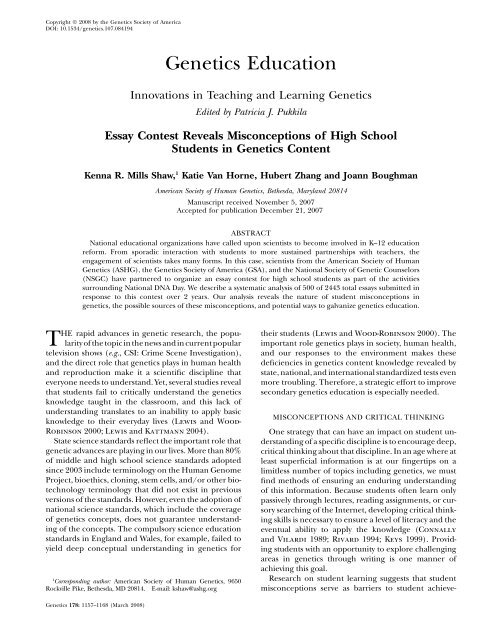
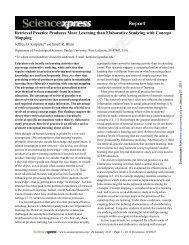
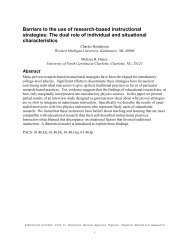
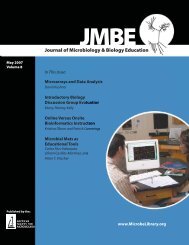
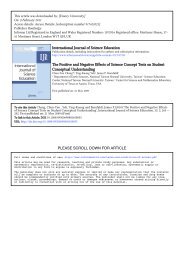
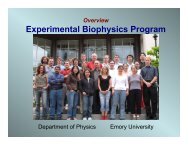
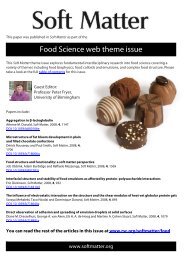

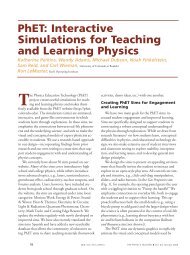
![view the Dish Show [PDF] - Department of Physics - Emory University](https://img.yumpu.com/45032745/1/190x146/view-the-dish-show-pdf-department-of-physics-emory-university.jpg?quality=85)

